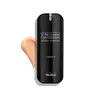What's inside
What's inside
 Key Ingredients
Key Ingredients

 Benefits
Benefits

 Concerns
Concerns

 Ingredients Side-by-side
Ingredients Side-by-side

Water
Skin ConditioningCaprylic/Capric Triglyceride
MaskingGlycerin
HumectantButylene Glycol
HumectantIsododecane
EmollientSqualane
EmollientCetearyl Alcohol
EmollientDimethicone
EmollientCetearyl Olivate
Sodium Acrylate/Sodium Acryloyldimethyl Taurate Copolymer
Emulsion StabilisingPolylactic Acid
AbrasiveCyclodextrin
AbsorbentPPG-12/Smdi Copolymer
EmollientSorbitan Olivate
EmulsifyingTitanium Dioxide
Cosmetic ColorantEclipta Prostrata Extract
Skin ConditioningPhenethyl Alcohol
MaskingMelia Azadirachta Leaf Extract
Skin ConditioningPhenoxyethanol
PreservativeCholesteryl Nonanoate
EmollientSodium Hyaluronate
HumectantTocopheryl Acetate
AntioxidantRubus Chamaemorus Seed Oil
Skin ConditioningCanola Oil
EmollientXanthan Gum
EmulsifyingPentylene Glycol
Skin ConditioningRetinal
Skin ConditioningRetinyl Retinoate
Skin ConditioningCitric Acid
BufferingAlumina
AbrasiveIsostearic Acid
CleansingLecithin
EmollientPolyglyceryl-3 Polyricinoleate
EmulsifyingPolyhydroxystearic Acid
EmulsifyingStearic Acid
CleansingCeramide AP
Skin ConditioningMoringa Oleifera Seed Oil
EmollientSodium Lauroyl Lactylate
EmulsifyingVanilla Planifolia Fruit Extract
Skin ConditioningEthylhexylglycerin
Skin ConditioningLinoleic Acid
CleansingPalmitic Acid
EmollientCeramide NP
Skin ConditioningDaucus Carota Sativa Seed Oil
EmollientDisodium EDTA
Phytosterols
Skin ConditioningLonicera Japonica Flower Extract
Skin Conditioning3-O-Ethyl Ascorbic Acid
Skin ConditioningLonicera Caprifolium Flower Extract
PerfumingSodium Polyaspartate
HumectantPhytosphingosine
Skin ConditioningParfum
MaskingCopper Palmitoyl Heptapeptide-14
Skin ConditioningHeptapeptide-15 Palmitate
Skin ConditioningCeramide EOP
Skin ConditioningCholesterol
EmollientC12-16 Alcohols
EmollientCaprylyl Glycol
EmollientCarbomer
Emulsion StabilisingHydrogenated Lecithin
EmulsifyingGlyceryl Caprylate
EmollientLactic Acid/Glycolic Acid Copolymer
Skin ConditioningPolyvinyl Alcohol
Phenylpropanol
MaskingBHT
AntioxidantLimonene
PerfumingLinalool
PerfumingCitral
PerfumingWater, Caprylic/Capric Triglyceride, Glycerin, Butylene Glycol, Isododecane, Squalane, Cetearyl Alcohol, Dimethicone, Cetearyl Olivate, Sodium Acrylate/Sodium Acryloyldimethyl Taurate Copolymer, Polylactic Acid, Cyclodextrin, PPG-12/Smdi Copolymer, Sorbitan Olivate, Titanium Dioxide, Eclipta Prostrata Extract, Phenethyl Alcohol, Melia Azadirachta Leaf Extract, Phenoxyethanol, Cholesteryl Nonanoate, Sodium Hyaluronate, Tocopheryl Acetate, Rubus Chamaemorus Seed Oil, Canola Oil, Xanthan Gum, Pentylene Glycol, Retinal, Retinyl Retinoate, Citric Acid, Alumina, Isostearic Acid, Lecithin, Polyglyceryl-3 Polyricinoleate, Polyhydroxystearic Acid, Stearic Acid, Ceramide AP, Moringa Oleifera Seed Oil, Sodium Lauroyl Lactylate, Vanilla Planifolia Fruit Extract, Ethylhexylglycerin, Linoleic Acid, Palmitic Acid, Ceramide NP, Daucus Carota Sativa Seed Oil, Disodium EDTA, Phytosterols, Lonicera Japonica Flower Extract, 3-O-Ethyl Ascorbic Acid, Lonicera Caprifolium Flower Extract, Sodium Polyaspartate, Phytosphingosine, Parfum, Copper Palmitoyl Heptapeptide-14, Heptapeptide-15 Palmitate, Ceramide EOP, Cholesterol, C12-16 Alcohols, Caprylyl Glycol, Carbomer, Hydrogenated Lecithin, Glyceryl Caprylate, Lactic Acid/Glycolic Acid Copolymer, Polyvinyl Alcohol, Phenylpropanol, BHT, Limonene, Linalool, Citral
 Reviews
Reviews

Ingredients Explained
These ingredients are found in both products.
Ingredients higher up in an ingredient list are typically present in a larger amount.
Retinal is a form of retinoid. Retinoids are the gold-standard class of anti-aging ingredients.
Retinal has many benefits as other retinoids: improve skin texture, reduce large pores, reduce the effects of aging, reduce the visibility of dark spots, heal scars, and fight acne.
Studies show retinal may work at a faster rate than retinol due to its structure.
All retinoids have to be converted into retinoic acid before starting to work. Some retinoids take several steps of conversion before binding. Retinal is only one step away, making it more potent.
Like other retinoids, retinal may be irritating. It is best to ease into using this ingredient frequently.
Using the 'ramp up' method, start by using retinol once a week. This gives your skin time to adjust and decrease irritation. Once you feel ready, you can slowly increase the frequency of retinol use.
Using retinoids will increase sun-sensitivity in the first few weeks of use. Though studies show retinoids increase your skin's natural SPF with continuous use, it is best to always wear sunscreen and sun-protection.
Learn more about RetinalSqualane is an emollient that helps the skin hold onto moisture. It's an oily liquid that occurs naturally in certain types of fish and plant oils.
Because squalane boosts hydration in the skin, it also comes with plenty of benefits: it is an antioxidant and can help fight free radicals and skin damage. Squalane is also found to have a detoxifying effect when applied.
Squalane comes from squalene, which occurs naturally within the sebum of our skin. It is one of the oils our skin produces to keep itself hydrated. Squalane is the hydrogenated version of squalene and has a longer shelf life.
Research shows that squalane is non-irritating (even at 100% concentration).
In general, it's a fantastic ingredient. It does a great job at hydrating the skin, and it's suitable for those with sensitive skin.
The source of squalane may impact malassezia / fungal acne. This is because olive oil derived squalane can contain impurities such as fatty acids and plant waxes. Sugarcane derived squalane is recommended for anyone with malassezia concerns.
Is squalane vegan?
This depends on the source. Squalane can be derived from both plants and animals. Most squalane used in skincare comes from plants.
Please note: the source of squalane is only known if disclosed by the brand. We recommend reaching out to the brand if you have any questions about their squalane.
Read more about squalene with an "e".
Is squalane an oil?
Squalane is often called an oil, but it’s technically not; it’s a hydrocarbon, meaning it’s only made of carbon and hydrogen, unlike true oils which are triglycerides made of fatty acids and glycerol.
The term “oil-free” isn’t regulated, so companies can define it however they want. Some exclude all oils, while others just avoid mineral oil or comedogenic oils.
While some people avoid oils thinking they cause breakouts, the right kind of oil (or oil-like ingredient like squalane) can actually help balance and hydrate your skin. It’s worth testing out simple oils or squalane to see what works best for your skin.
Learn more about Squalane